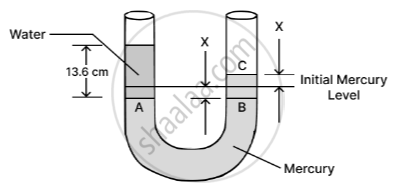Advertisements
Advertisements
प्रश्न
A simple U tube contains mercury to the same level in both of its arms. If water is poured to a height of 13.6 cm in one arm, how much will be the rise in mercury level in the other arm?
Given : density of mercury = 13.6 x 103 kg m-3 and density of water = 103 kg m-3.
उत्तर
Given, ρm = 13.6 × 103 kg m -3, ρw = 103 kg m -3
Height to which water is poured in one arm, hw = 13.6 cm

By pouring 13.6 cm of water, the mercury level in the left arm goes down to point A by x cm, while in the right arm, it rises to point C by x cm. Therefore, BC = hm = 2x cm
By Pascal's law,
Pressure in the water column = pressure in the mercury column
Therefore, PA = PB
⇒ hw ρw g = hm ρm g
⇒ 13.6 × 103 × g = 2𝑥 × 13.6 × 103 × g
⇒ 1 = 2𝑥
⇒ 𝑥 = `1/2` = 0.5 cm
Hence, the rise in mercury level = 0.5 cm
APPEARS IN
संबंधित प्रश्न
What is upthrust ?
When a boat is partially immersed in water, it displaces 600 kg of water. How much is the buoyant force acting on the boat in newtons ? (g = 10 m s-2)
What is a density bottle? How is it used to find the density of a liquid?
Pressure at the free surface of a water lake is P1, while at a point at depth h below its free surface is P2. (a) How are P1 and P2 related? (b)Which is more P1 or P2?
What is the cause of upthrust? At which point can it be considered to act?
Calculate the hydrostatic pressure exerted by water at the bottom of a beaker. Take the depth of water as 40 cm, the density of water 1000 kgm−3 and g = 9.8 ms−2.
Write the SI units of Buoyant force
How is thrust different from pressure?
Salt water provides less buoyant force than freshwater.
Assertion (A): The buoyant force on a submerged rigid object can be considered to be acting at the center of mass of the object.
Reason (R): In rigid body, force distributed uniformly through its volume can be considered to be acting at the centre of mass of the body.
